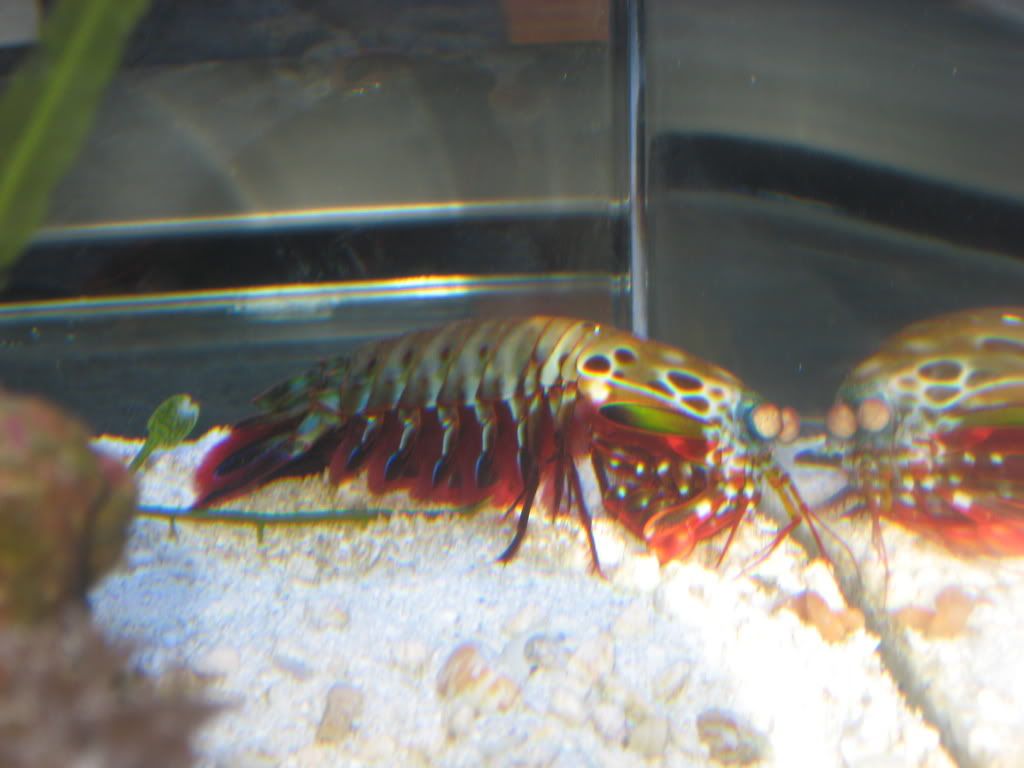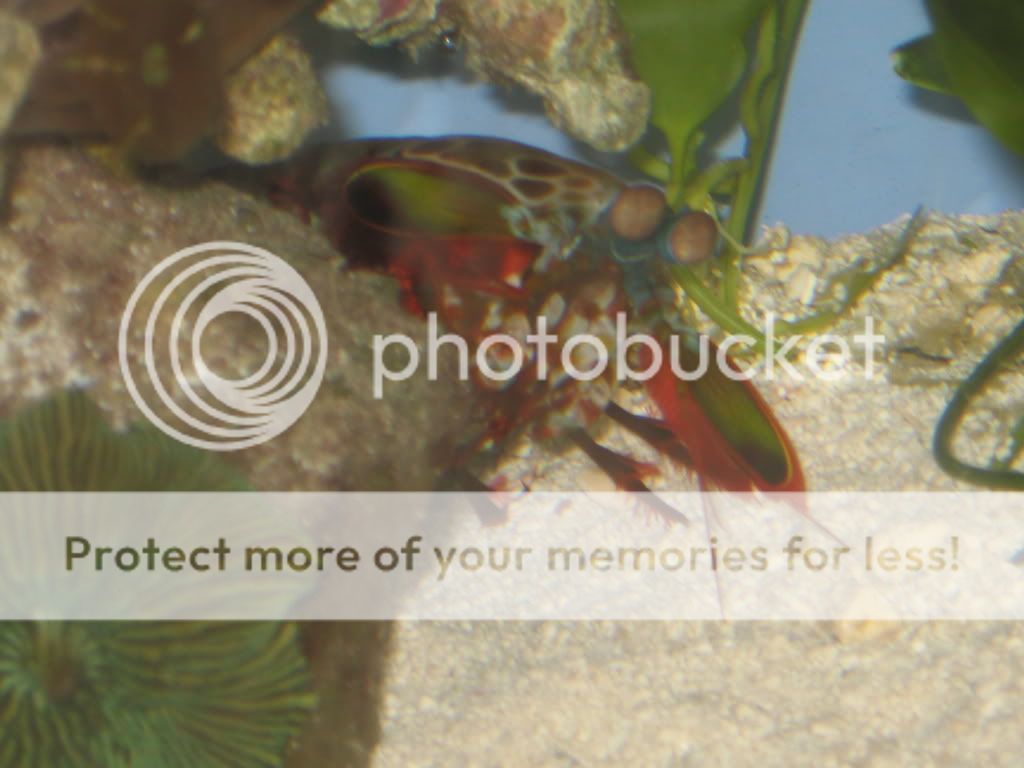chrissaysyes
Nereus
Common Name(s):Peacock Mantis Shrimp, Clown Mantis Shrimp, Painted Mantis, Harlequin Mantis Shrimp
Scientific Name: Odontodactylus scyllarus:
Family: Odontodactylidae
Origin: Indo-Pacific
Max Size: ~7"
Care: This animal belongs to the Smasher Mantis Shrimp family. They have a very developed club-like appendage that includes a very sharp spear. The club is used to smash and stun prey, also to crack open shells and to bash rocks to create burrows. The spear can also be used to fight predators and sometimes to slash at fish or other soft fleshed prey. This is not to be confused with the barbed spear appendages of other mantids known as “spearers.” The optimal habitat for the Mantis Shrimp is sand or gravel with some live rock. It creates burrows and readily accepts PVC as a synthetic burrow. It is very important in the aquarium to provide ample rock work and shady places for this animal. It’s eyes are very sensitive to light and they naturally live in dim areas. High lighting with no relief can cause a great deal of stress.
The Peacock Mantis is most commonly diurnal. It can be seen during the day wandering the rocks and even the open substrate. It will also playfully interact with anything coming in contact with its tank. It’s not uncommon for owners of mantids to play a game of peak-a-boo around rock work with the animal.
Feeding: Food substrates include gastropods, bivalves and thawed krill You can feed any marine flesh but, a note about silversides. Some have expressed concerns over the fact that mantids do not feed on silversides in the wild. Also, it is believed that frozen silversides can go bad and easily be very detrimental to the mantis. Feeding can be done by simply introducing live animals such as snails into the mantid’s environment and allowing him to naturally prey upon them; or by introducing the food via a feeding stick and dangling it in front of the animal to entice an attack.
Caution: These animals make for wonderful pets when provided with the correct aquarium. It is important to note that they do have the ability to not only cause damage to their owner but to their aquarium. Some important things to note when creating a habitat for a Peacock Mantis:
Photographs:



Scientific Name: Odontodactylus scyllarus:
Family: Odontodactylidae
Origin: Indo-Pacific
Max Size: ~7"
Care: This animal belongs to the Smasher Mantis Shrimp family. They have a very developed club-like appendage that includes a very sharp spear. The club is used to smash and stun prey, also to crack open shells and to bash rocks to create burrows. The spear can also be used to fight predators and sometimes to slash at fish or other soft fleshed prey. This is not to be confused with the barbed spear appendages of other mantids known as “spearers.” The optimal habitat for the Mantis Shrimp is sand or gravel with some live rock. It creates burrows and readily accepts PVC as a synthetic burrow. It is very important in the aquarium to provide ample rock work and shady places for this animal. It’s eyes are very sensitive to light and they naturally live in dim areas. High lighting with no relief can cause a great deal of stress.
The Peacock Mantis is most commonly diurnal. It can be seen during the day wandering the rocks and even the open substrate. It will also playfully interact with anything coming in contact with its tank. It’s not uncommon for owners of mantids to play a game of peak-a-boo around rock work with the animal.
Feeding: Food substrates include gastropods, bivalves and thawed krill You can feed any marine flesh but, a note about silversides. Some have expressed concerns over the fact that mantids do not feed on silversides in the wild. Also, it is believed that frozen silversides can go bad and easily be very detrimental to the mantis. Feeding can be done by simply introducing live animals such as snails into the mantid’s environment and allowing him to naturally prey upon them; or by introducing the food via a feeding stick and dangling it in front of the animal to entice an attack.
Caution: These animals make for wonderful pets when provided with the correct aquarium. It is important to note that they do have the ability to not only cause damage to their owner but to their aquarium. Some important things to note when creating a habitat for a Peacock Mantis:
- If possible, avoid Metal Halide lighting. It is possible to acclimate these animals to MH however it is not natural or necessary for them to be introduced to such strong lighting. If possible power compact lighting is a much more healthy solution. It is still important to provide places where the mantid can seek out absolute darkness.
- Provide PLENTY of rocks for hiding and ideally PVC pipe for easy access burrows. A lot of people worry when purchasing a Mantid that the animal will simply go into the rock work and never again surface, therefore they go light on giving him hiding places. This is not necessary with the Peacock. More than likely he will not disappear into the rocks and never be seen again but he will remain active outside of his burrow—especially once accustomed to his owner.
- Acclimate SLOWLY and in DARKNESS. These animals have a reputation for being very hardy and difficult to rid some tanks of. Although this is true with some species it is not as true with peacocks when it comes to acclimatization. It is important to give them the same gradual acclimation that you would any other sensitive inhabitant. It is also important to note that they have very sensitive and powerful eye sight. After being shipped or concealed away from light it can be VERY stressful to introduce them directly into a completely new and very bright environment. An example was presented to me once in the comparison of going to see a two hour movie and then walking out of the movie into the daylight. It would be a similar situation for the mantis.
- Mantids can chip glass and have broken tanks before. This is not an urban legend. Many people feel that they should NEVER be kept in glass tanks and rather acrylic be used. Some say that a simple acrylic false bottom is enough to guard your aquarium. This varies from species to species. O. scyllarus is less known for breaking out of tanks or crushing heaters but this is still a precaution that should seriously be addressed.
- Last but maybe more importantly, they are known as 'thumb splitters' for a reason! They can and more than likely will inflict very painful injuries upon you when given the opportunity. Do NOT ever put your fingers in front of or even near the mantis. Injuries can range from a very nasty wound with possibility of infection, to broken bones. Injuries that occur in a marine environment by a marine animal can be predisposed to unusual bacterial infections. BEWARE!
Photographs:





